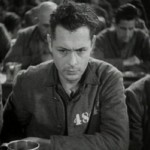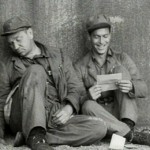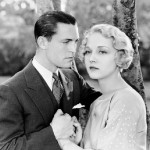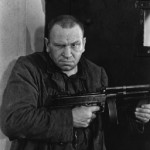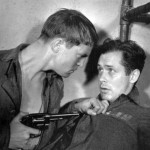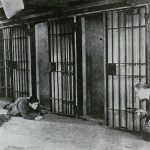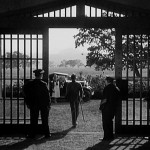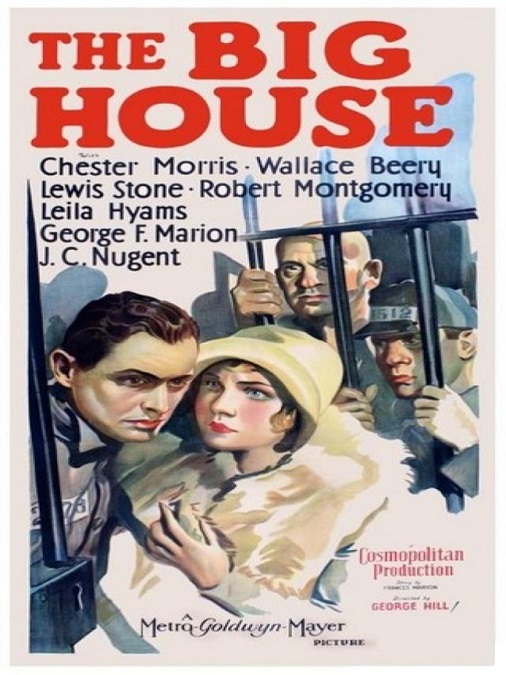

The Big House – 1929 / 1930
This was a pretty average movie. It was not too long, but not too short. It had a bit of lead-up and a bit of action, though it was all a bit predictable. The acting wasn’t bad but it wasn’t great. The characters were one-dimensional stereotypes, but they were fun to watch anyway. There was nothing that really made the film stand out as above average, but I still enjoyed watching it.
It starred Wallace Beery as its big name, though he didn’t play the lead. That honor was taken by Chester Morris, playing the part of Morgan, a prison inmate who is in jail for robbery. Beery plays his cellmate, Butch, who is serving a life sentence for multiple murders. At first, I was lead to believe that the leading man was Kent, played by Robert Montgomery, a law-abiding citizen who has been sentenced to 10 years for vehicular manslaughter while driving drunk.
Kent enters the prison as a scared young boy. As the prison is overcrowded, he is placed in a cell with Butch and Morgan. Butch tries to bully him, but Morgan helps protect him. Angry at the disgusting food, and his bleak future, Butch constantly talks about starting a big jail-break, but Morgan is always successful at talking him out of it.
The prison’s warden, played by Lewis Stone, lets Kent know that he can get his sentence reduced if he becomes a stool-pigeon. He endeavors to befriend Butch and Morgan who are the leaders of the inmates in an effort to learn Butch’s plans for breaking out. One day, Morgan’s parole is approved, but through an unfortunate series of events, Kent messes it up for him.
What follows is Morgan’s successful escape, his romance with Kent’s sister, his re-incarceration, and Butch’s attempt at a major prison riot and escape. The riot scene was exciting enough to watch, the slow pace of the film finally picking up for a few minutes. There were inmates and guards running everywhere, lots of machine gun fire, smoke, men getting shot, and tanks.
But I have to mention two things that made me roll my eyes. First was a little thing about an unnamed inmate during the riot sequence. He was the man who, after the prison guards were herded into a cell to await execution as part of Butch’s negotiation tactics, was given the cell keys. He is shot and falls to the floor, apparently dead. Morgan takes the keys and locks the cell, denying Butch access to the hostages. When Morgan takes the keys, he feebly reaches for them and the collapses. Then, several minutes later, when Butch arrives and demands the keys, he suddenly moves again, just enough to point in the direction in which Morgan ran. “Um… I’m not quite dead, sir!”
The other thing which I have to roll my eyes at is the speed with which Morgan’s sister, Anne, played by Leila Hyams, falls in love with Morgan, a man who she knows to be the dangerous escaped criminal. It just goes to show that women in 1929 were all powerless against strong, handsome leading men. And of course, her love inspires Morgan to “go straight” and give up his law-breaking ways. OK – suspension of disbelief.
But the film, despite its obvious flaws, was fun to watch. Beery’s performance, while nothing to write home about, was entertaining, and had a little bit of depth. He portrayed his character as slow, uneducated, and violent, with a complete lack of morals. He casually talks about men and women he’d murdered with the other inmates. His portrayal, if anything, made the movie interesting to watch.
But watch out for the film’s final scene. I say this, not for what happens in the story, but for how abrupt it is. I have found that there are many movies from the late 20s and early 30s that do the same thing. The main story ends, and there is about a minute and a half, if that, of epilogue before the “The End” appears on the screen. It happens so quickly that there seems to have been very little thought behind it. Once the main plot is ended, give a quick nod to closure, and we’re done! Roll credits! A little more of an engaging epilogue would have served this movie well.


